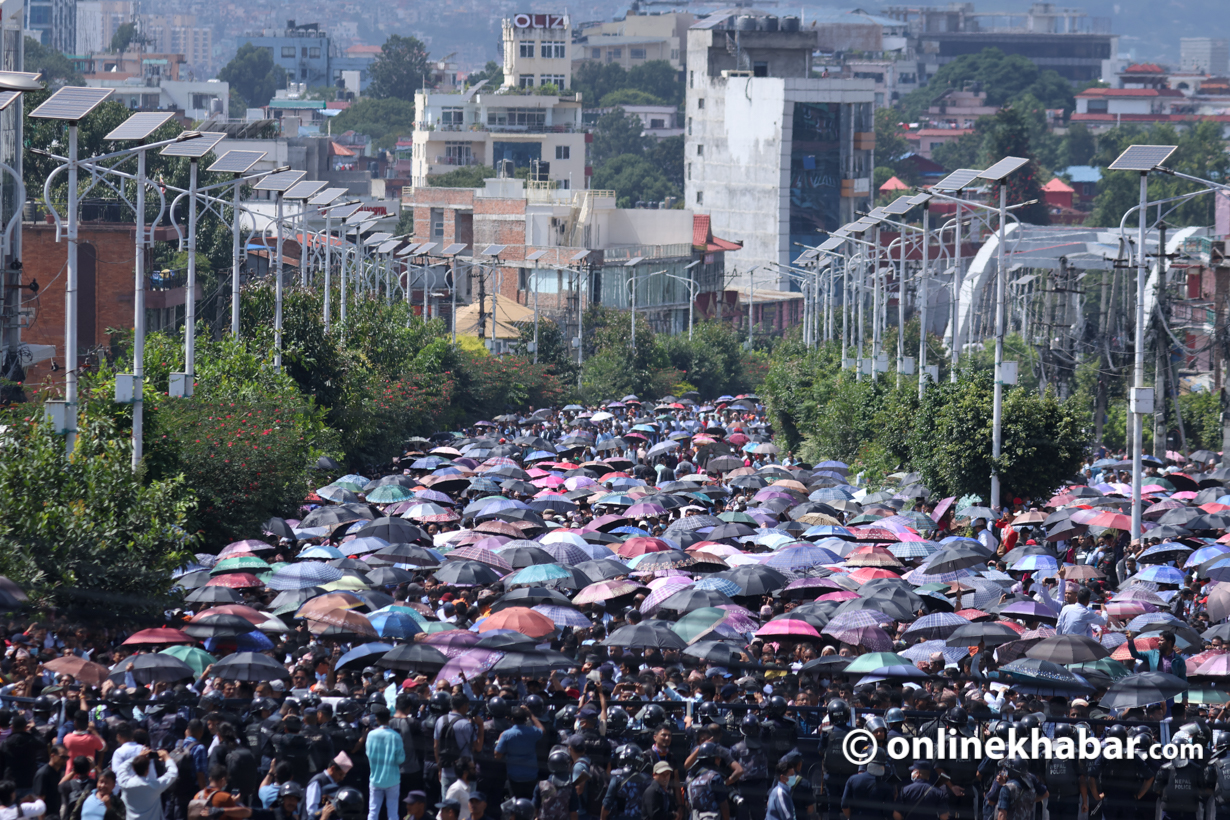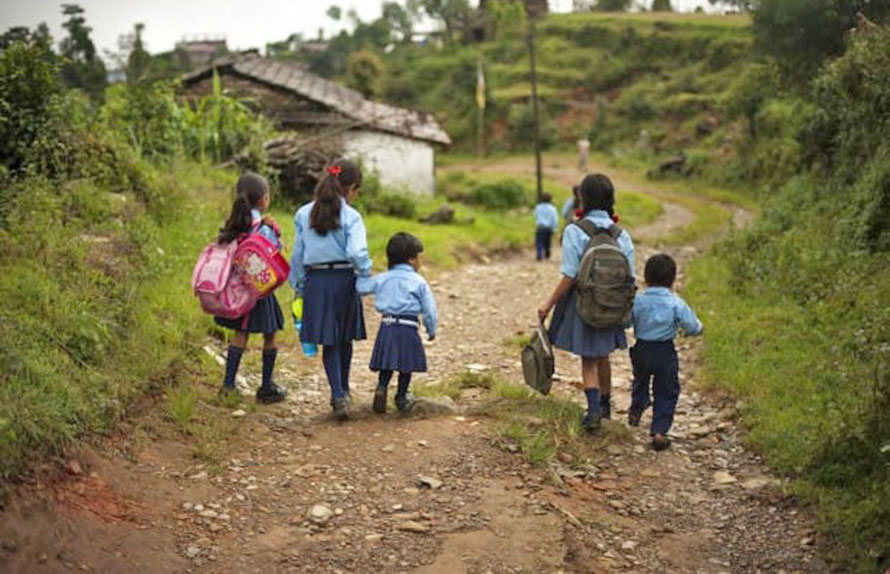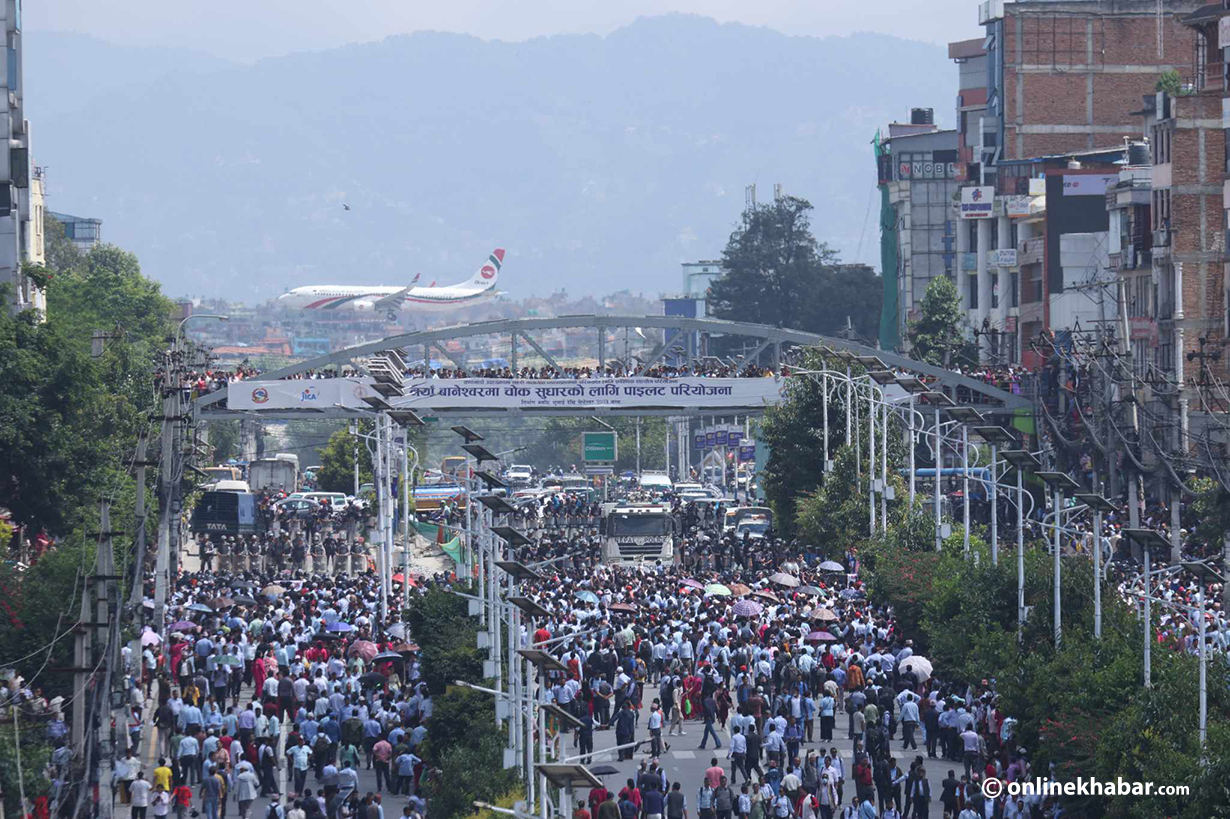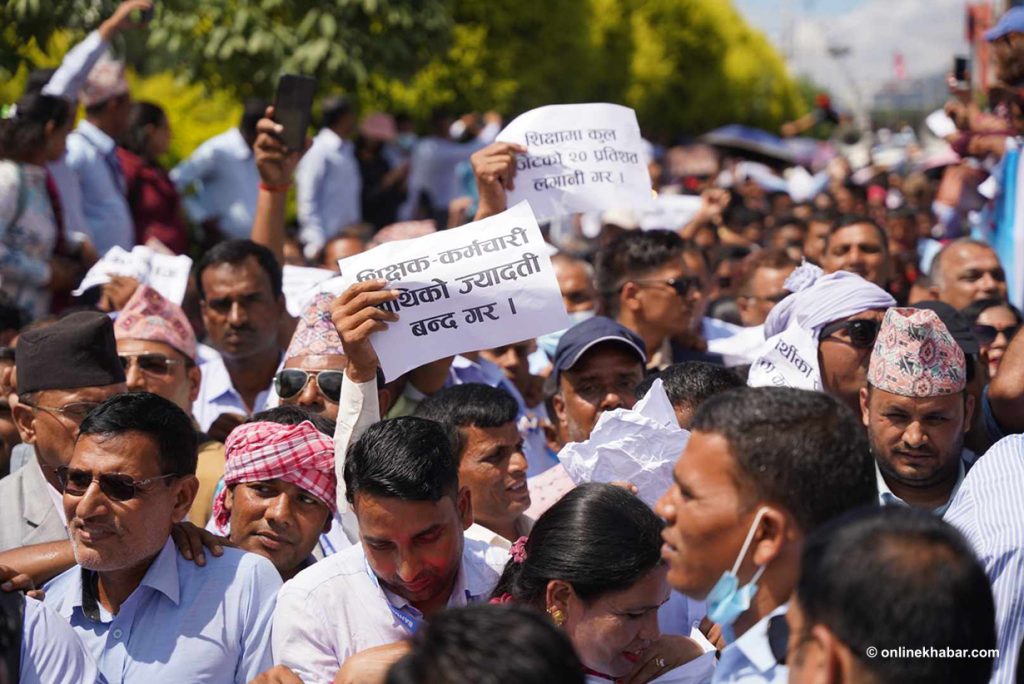
It is shocking to see a sizable crowd of educators from all over the country protesting the recently tabled Education Bill. Contrary to the prevailing notion that these teachers were mere pawns of political parties, this spectacle sparked serious questions.
What are the driving forces behind the Education Bill controversy?
Transitioning to a non-profit education system, the proposed bill advocates for the conversion of over 8,000 private schools into the non-profit Guthi system, aiming to mitigate commercialisation and enhance educational accessibility.
However, a critical inquiry arises: Is this approach appropriate, and has research been conducted to assess the efficiency and effectiveness of the non-profit Guthi system in comparison to current private schools?
It is crucial to carefully analyse potential consequences and strike a balance that ensures educational quality while addressing the issue of profit-driven motives. Balancing socio-economic factors and considering the educational capabilities of communities is paramount in shaping an approach that effectively addresses Nepal’s specific needs and challenges.
The Education Bill and the challenges are explained below:
Empowering local authorities: Is decentralisation the way forward?

A significant shift in authority has occurred with the education bill proposing the decentralisation of educational responsibilities, particularly the transition from the district education office to local municipalities.
Previously, the district education office oversaw school construction, but now municipalities will play a vital role. It will be responsible for appointing school principals based on teacher examinations. While adhering to national standards, local level will have the autonomy to manage public schools, regulate operations, and oversee teachers
The municipalities’ heads are elected by the people without any specific educational requirements. This raises a critical question—do the elected heads of municipalities possess the necessary capabilities to effectively carry out these responsibilities, or should the task remain with the district education office, headed by a qualified individual who has successfully cleared the demanding Lok Sewa examination in Nepal?
Another pressing concern revolves around the financial implications for municipalities when establishing new schools. In cities like Kathmandu and Lalitpur, municipalities generate substantial revenue through taxes levied on citizens and businesses. However, the collected tax revenue varies across different municipalities. The question thus arises: how can rural municipalities muster the necessary funds to establish, manage, and compensate teachers for new public schools, given their limited tax revenue and financial resources?
Addressing these fundamental questions is crucial to ensuring the effective implementation of decentralisation efforts. Striking a balance between local empowerment and educational quality, especially in financially constrained rural areas, is essential and needs to be addressed in the education bill.
Additionally, exploring sustainable funding mechanisms and considering equitable distribution of resources will be pivotal in bolstering educational opportunities for all, regardless of geographic location and economic capacity.
What language to use?

The education bill has a regulation stipulating computer science and mathematics will exclusively taught in English. This is a policy I firmly oppose. The origins and rationale behind implementing this rule remain unclear, leaving me puzzled about the considerations that led to its adoption.
Subjects like science and mathematics are inherently challenging to study, and mandating they be taught in English, a language not commonly mastered as a second language by most Nepalis, poses a significant obstacle.
Even developed nations do not enforce compulsory instruction in these subjects in English. Therefore, it is essential to contemplate the primary objective of teaching these subjects.
Is it to enhance English fluency or to impart fundamental knowledge about math and science? Personally, I pursued my math education in Nepali until the fifth grade, and the transition to English instruction in the sixth grade did not deter my passion for these subjects.
Moreover, I excelled in math, securing the highest score in my class and eventually earning a gold medal during my masters. Learning in Nepali did not weaken my academic prowess; in fact, it laid a strong foundation for my understanding of math and science.
Upon reviewing this directive, it is apparent to me that the new regulation seems inclined to gradually eradicate our native language, Nepali, from the education system. Is this what the education bill wants to do?
This raises valid concerns about the implications this might hold for the future. There’s a well-known saying, “What is a nation without a mother tongue?” by Jack Edwards, underscoring the critical role of a mother tongue in preserving culture and identity.
This move could jeopardise Nepali students, many of whom are not proficient in English, potentially exacerbating the disparity in educational opportunities between students in urban centres like Kathmandu and those in smaller towns and villages.
Specific directives promoting inclusive education

In order to support children with special needs, provisions have been made for open and mobile schools, particularly in geographically challenging regions.
Allocated welfare funds are now designated for the establishment and operation of model or specialised schools, guaranteeing a superior standard of education encompassing various subjects. This progressive step within the education bill is applauded, emphasising the imperative of inclusivity in education.
Regulations affecting foreign and private schools

This regulation imposes constraints on the fee structures of private schools, aligning them with local and national laws. In recent times, the cost of private education has surged significantly, making it challenging for parents to afford high fee structures.
However, economic principles of supply and demand underscore that schools can charge these amounts due to existing demand. If parents are unwilling to pay such fees, schools cannot sustain these charges and may lose students.
Implementing fee limitations may indeed affect the quality of education due to reduced funding, potentially driving parents to opt for education in other countries.
Teaching licences and advanced credentials

The stipulation of teaching licences as a prerequisite for employment is a commendable initiative put forward by the education bill. However, mandating a master’s degree for educators at the basic level in the context of Nepal raises questions about feasibility and practicality. Striking a balance between stringent qualifications and the availability of qualified teachers is crucial to ensuring an adequate teaching force.
Inclusive hiring and gender representation
While promoting gender inclusivity in teacher recruitment is important, practical considerations must be acknowledged. The designated quota for women in education exams aims to bolster female representation in the teaching profession. Yet striking the right balance between qualification requirements and inclusivity is essential to maintaining educational standards.
Challenges in teacher benefits and incentives
The decision to discontinue pensions for teachers post from March 18, 2019, raises concerns about teacher incentives and overall morale. Teaching, often considered a fallback option, requires appropriate incentives to attract and retain qualified individuals. Addressing the disparity in benefits compared to other civil servants and ensuring adequate incentives is vital for motivating teachers and sustaining a dedicated workforce. For instance, civil servants are entitled to discounted healthcare services at the Civil Hospital in Baneshwar, Kathmandu, whereas teachers are not offered the same benefit.

Balancing teacher leaves and responsibilities
The provision of automatic dismissal after a 15-day break for teachers warrants careful consideration. While this rule intends to maintain attendance and accountability, it should be applied judiciously. Instances of genuine need, such as medical emergencies, should be accommodated through a structured system of substitute teachers, ensuring that frivolous excuses for extended leaves are appropriately addressed while safeguarding teachers’ rights.
Maintaining political neutrality among teachers
Regulation in the education bill ensures that educators refrain from engaging in political activities, thus fostering an impartial and unbiased learning atmosphere within schools. In a democratic society, it is imperative to avoid bias in hiring based on political affiliations. I, myself, do not align with any political party, appreciating the freedom to choose in our democratic nation. An individual’s actions outside of their professional hours, within legal bounds, should remain their personal concern and not be imposed upon the educational environment. This includes refraining from expressing political opinions to students, even for those not affiliated with any political stance.
Local level exams: Evaluating a shift from centralised assessments

The proposal to conduct Class 8 and Class 12 exams at the local level marks a departure from the current centralised assessment approach. The responsibility of preparing the Class 8 Board Exam Question Paper will rest with the District Education Office.
Moreover, after nearly a century of existence, the School Leaving Certificate/ Secondary Education Examination (SLC/SEE) examination control office for Class 10 will be discontinued, with schools administering the exams. However, the suitability of this shift for Nepal warrants careful consideration.
In the existing education system, students study until SEE (Secondary Education Examination) and then choose between vocational education, +2, or internationally affiliated degrees. Students often engage in part-time jobs to meet their financial needs.
One concern lies in the provision for students aspiring to pursue foreign university-affiliated courses like IB and A-levels. If this option is not adequately accommodated within the local exam system, parents and students may opt to seek these degrees abroad, resulting in a loss of foreign currency for Nepal.
To ensure that Nepal has a wide range of educational options, the move towards localised exams should come with thoughtful provisions for students hoping to pursue international curricula. This will help retain students within the country and contribute to the national economy by minimising the outflow of funds for education sought abroad.
Balancing local assessment with opportunities for pursuing diverse educational paths is crucial for the overall growth and development of the education sector in Nepal.





















